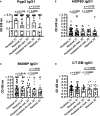Antibody responses to Chlamydia trachomatis vaccine candidate antigens in Chlamydia-infected women and correlation with antibody-mediated phagocytosis of elementary bodies
- PMID: 38371301
- PMCID: PMC10869445
- DOI: 10.3389/fcimb.2024.1342621
Antibody responses to Chlamydia trachomatis vaccine candidate antigens in Chlamydia-infected women and correlation with antibody-mediated phagocytosis of elementary bodies
Abstract
Murine research has revealed a significant role for antibody responses in protection against Chlamydia reinfection. To explore potential humoral immune markers of protection elicited by Chlamydia trachomatis (CT) antigens in humans in the context of presumed clinical correlates of protection, we used both an IgG1-based ELISA and a conventional total IgG ELISA to evaluate antibody responses. We evaluated responses to five CT outer membrane proteins (PmpE, PmpF, PmpG, PmpH, and MOMP), along with other promising CT antigens (Pgp3 and HSP60), negative control antigens (RecO and AtpE), and CT elementary bodies (EBs) in sera from a well-characterized cohort of 60 women with different CT infection outcomes, including two outcomes that are likely clinical correlates of protective immunity: spontaneous resolution of infection and absence of reinfection after treatment. Furthermore, we used a flow cytometry-based assay to measure antibody-mediated phagocytosis by neutrophils in these sera. Results demonstrated that IgG1 ELISA displayed higher sensitivity than conventional total IgG ELISA in assessing antibody responses to CT EBs and antigens. Pgp3 IgG1 ELISA exhibited the highest sensitivity compared to IgG1 ELISA incorporating CT EBs or other antigens, confirming Pgp3 IgG1 ELISA as an ideal assay for CT antibody detection. Most (95%) sera from women with CT infection outcomes exhibited antibody-mediated phagocytosis of CT EBs, which was significantly correlated with IgG1 antibody responses to MOMP, Pgp3, HSP60, and PmpF. However, neither IgG1 responses to CT antigens and EBs nor antibody-mediated phagocytosis were associated with clinical correlates of protection. These findings suggest that neither CT IgG1 antibody detection nor antibody-mediated phagocytosis will be useful as immune correlates of protection against CT infection in humans.
Keywords: Chlamydia; IgG1 ELISA; Pgp3; antibody; antibody-mediated phagocytosis; antigen; serology.
Copyright © 2024 Yu, Geisler, Dai, Gupta, Cutter and Brunham.
Conflict of interest statement
The authors declare that the research was conducted in the absence of any commercial or financial relationships that could be construed as a potential conflict of interest.
Figures





References
-
- Bakshi R. K., Gupta K., Jordan S. J., Chi X., Lensing S. Y., Press C. G., et al. . (2018). An adaptive chlamydia trachomatis-specific ifn-gamma-producing cd4(+) T cell response is associated with protection against chlamydia reinfection in women. Front. Immunol. 9, 1981. doi: 10.3389/fimmu.2018.01981 - DOI - PMC - PubMed
-
- Barral R., Desai R., Zheng X., Frazer L. C., Sucato G. S., Haggerty C. L., et al. . (2014). Frequency of chlamydia trachomatis-specific T cell interferon-gamma and interleukin-17 responses in cd4-enriched peripheral blood mononuclear cells of sexually active adolescent females. J. Reprod. Immunol. 103, 29–37. doi: 10.1016/j.jri.2014.01.002 - DOI - PMC - PubMed
-
- Bhuvanendran Pillai A., Mun Wong C., Dalila Inche Zainal Abidin N., Fazlinda Syed Nor S., Fathulzhafran Mohamed Hanan M., Rasidah Abd Ghani S., et al. . (2022). Chlamydia infection as A risk factor for cervical cancer: A systematic review and meta-analysis. Iran J. Public Health 51, 508–517. doi: 10.18502/ijph.v51i6.9705 - DOI - PMC - PubMed
Publication types
MeSH terms
Substances
Grants and funding
LinkOut - more resources
Full Text Sources
Medical
Research Materials
Miscellaneous

